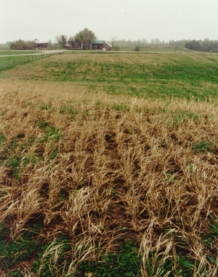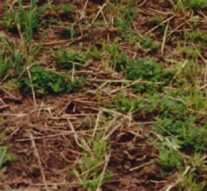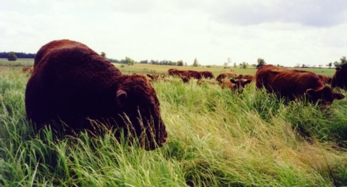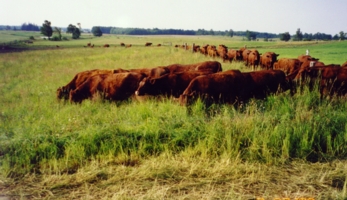|
|
|
|
|
|
|
|
|
Yield (T/Ha) |
|
|
|
|
NDF |
|
|
|
|
ADF |
|
|
|
|
Lignin |
|
|
|
| |
|
| |
|
 |
 |
|
|
|
As seen in the photo above, left, the Switchgrass did provide a reasonable cover, suitable for duck nesting habitat. The green in the photo is black medic, a weed that seemed to persist inspite of the numerous sprayings of these plots. The above photo on the right shows the emergence of the Big Bluestem as the light green grass, again with the presence of black medic. The Big Bluestem failed to produce much regrowth after the clipping in 1999 and it was a worry that this warm season species would not have sufficient reserves to survive the winter and grow again in the spring of 2000. At this stage, in the spring of 2000, it appeared that the Big Bluestem had survived fairly well.
|
|
|
|
|
|
|
| Switchgrass '99 |
|
||||
| Switchgrass '00 |
|
|
|
|
|
| Big Bluestem '99 |
|
||||
| Big Bluestem '00 |
|
|
|
|
|
| Mixed '99 |
|
||||
| Mixed '00 |
|
|
|
|
|
The results in the above table show how dramatically the Big Bluestem production has decreased (56%) from the previous year. One might also conclude, from the relatively high % utilization figures of the Switchgrass, that the increased presence of cool season grasses (mature at the time of grazing) and weeds in the other two plots contributed to the decreased consumption by the cattle. The Switchgrass has maintained a relatively thick stand while the other plots have shown a noticable thinning.
After the mid summer grazing, the warm season grass plots were untouched for the remainder of the growing season in order to encourage the grasses to build up their reserves for the winter.


There were only a few photos taken in 2001 and unfortunately no forage measurements were collected for analysis. 2001 saw a large difference in warm season grass population in the three plots with only a few specimens surviving in the Big Bluestem and the mixed plot. An estimate, by the author, of a 40% to 50% stand of Switchgrass remained in the first paddock in the fall of 2001. In a field immediately adjacent to the warm season grass plots a pasture mixture was sown in 1999 (orchard grass, timothy, alfalfa, trefoil, and ladino). To be fair, the soil and drainage conditions are superior in the pasture mixture field but, taking this into account, there is little doubt in the author's mind that the pasture mixture field surpasses the best of the warm season, switchgrass, production.
There appear to be two major disadvantages for warm season grasses in our location.
The first is related to the requirement for a warm season grass to enter the winter with at least 8 inches of top growth to survivie. The switch grass was able to do this but only if grazing was prohibited after mid August. The other warm season species did not appear to have sufficient regrowth time even if grazing was stopped at the end of July. As a consequence, the warm season plots have only been grazed once each growing season. The adjacent cool season grass field was grazed four times this summer providing many more days of production.
The second disadvantage may be related to the first. All of the paddocks have now been invaded by cool season grasses, clovers, trefoil, and weeds. It appears that the warm season grasses are not able to compete by maintaining a thick sward. This stand reduction may be due to winter kill of specific plants or it may be the result of early spring competion from these invading species that have the ability to far outpace the warm season grasses during the period. Warm season grass seed is not inexpensive. These fields were planted in 1998 with no forage grazed during that year. Production was good in 1999 and 2000 for the switch grass. 2001 warm season grass production appeared to be significantly reduced although no direct measurements were taken. The author would estimate that the best of the warm season grasses, Switchgrass, would only be productive for 4 years in the North Dufferin area of Ontario. When one compares a well managed cool season legume, grass pasture to Switchgrass pasture in this location, the majority of the advantages are with the cool season pasture.